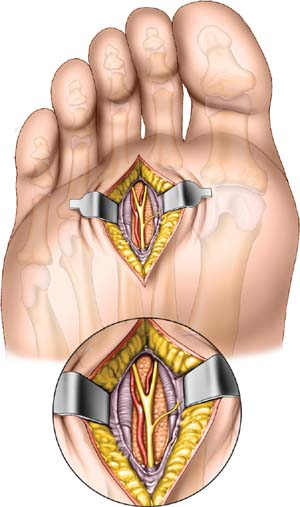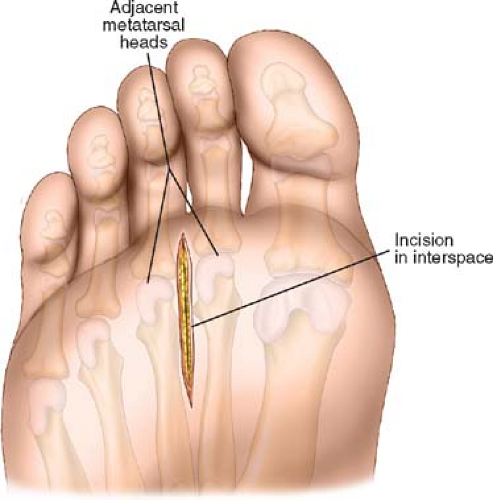 Plantar Approach for Recurrent Morton’s Neuroma
Plantar Approach for Recurrent Morton’s NeuromaThe plantar approach for a digital neuroma gives excellent exposure of the common plantar digital nerve. The approach can be extended proximally to expose more of the nerve. The major disadvantage of the incision is that it creates a plantar scar. Healing time is often longer than the dorsal approach. Plantar scars are occasionally sensitive.
The alternative surgical approach—the dorsal approach—divides the deep transverse metatarsal ligament, which may be an important source of pathology in the creation of Morton’s neuroma. For that reason, the plantar approach for Morton’s neuroma is usually reserved for exploration of a recurrent neuroma rather than as the primary procedure for treating this pathology.
Position of the Patient
Place the patient supine on the operating table. Apply a tourniquet either at the midpoint of the thigh or just above the ankle after the leg has been exsanguinated. Alternatively, use a soft rubber bandage to exsanguinate the foot, then use the bandage as a tourniquet at the ankle (see Fig. 1-1).
Landmarks and Incision
To palpate each metatarsal head, place the thumb on the plantar surface and the index finger on the dorsal surface of the foot. The skin under the metatarsal heads may be thickened; this may also be used as a landmark.
 Figure 47-1 Make a 4- to 5-cm longitudinal incision from the plantar aspect of the sole of foot overlying the interspace to be explored. Begin the incision just distal to the level of the metatarsophalangeal joint and proceed proximally.
Stay updated, free articles. Join our Telegram channel
Full access? Get Clinical Tree
 Get Clinical Tree app for offline access
Get Clinical Tree app for offline access

|